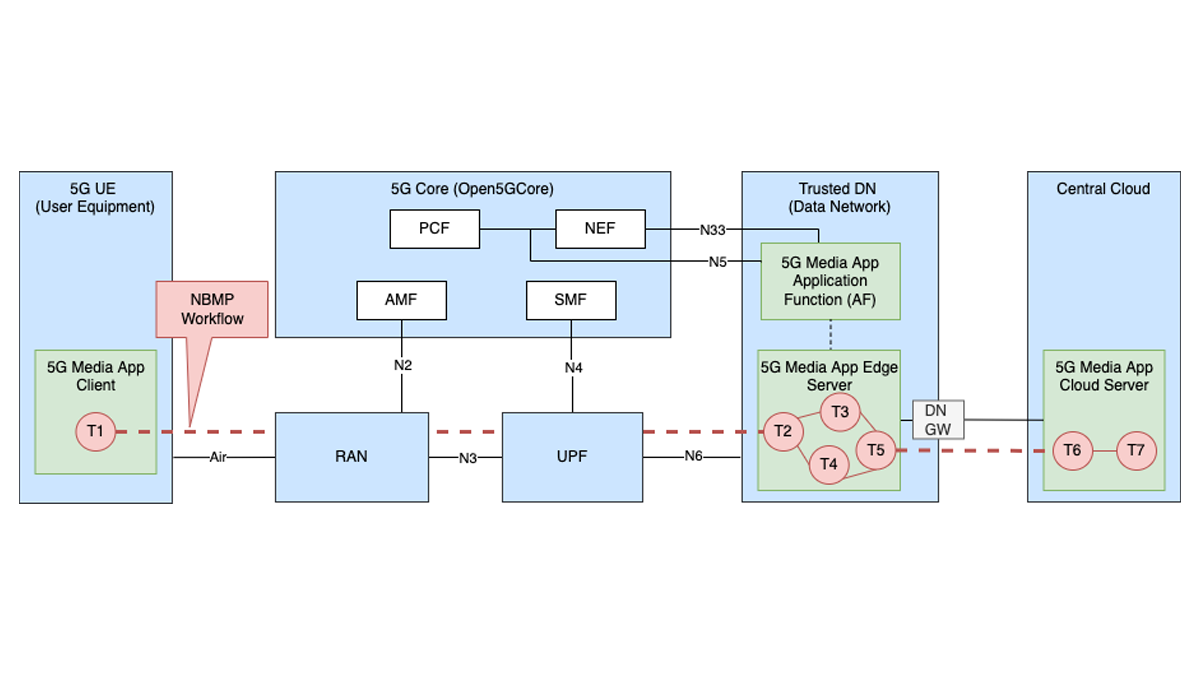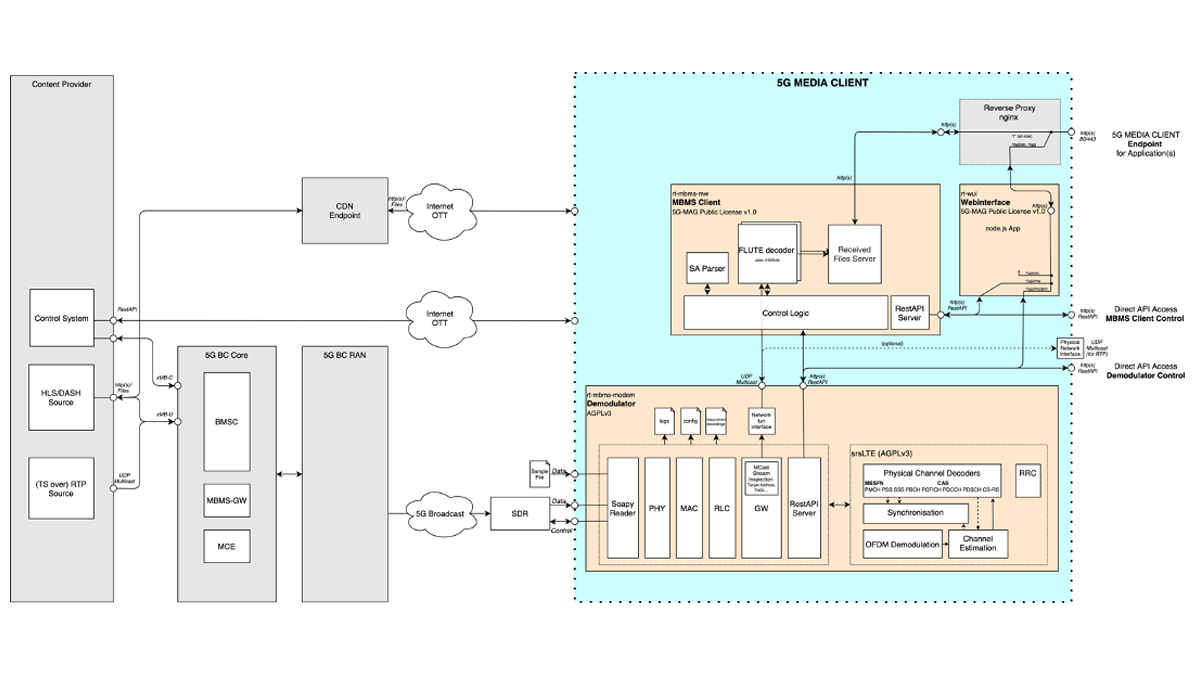The FAME 5G Media Testbed (F5GMT) enables the development, testing, evaluation and demonstrations of Media Applications and Services operated within a 5G and in the future in 6G environments. It runs on top of the Fraunhofer FOKUS Open5GCore implementation and commercial off-the-shelf 5G New Radio (NR) Hardware Equipment. It supports 5G Multimedia Streaming applications powered by 5G Multi-Access/Mobile Edge Computing (MEC) and 5G Multimedia Broadcast Multicast Services Streaming capabilities powered by 5G-MAG. It also incorporates the Network Based Media Processing (NBMP) standard with 5G technology to easily create, deploy and run Media Workflows. The 5G Media Streaming client is built on top of the DASH Reference Player dash.js.
5G Media Testbed
Tabbed contents
5G Multimedia Streaming
5G Multimedia Streaming
The FAME 5G Media Testbed is build as shown in the diagram below on top of the Fraunhofer FOKUS Open5GCore, a worldwide first practical implementation of the 3GPP 5G core network and supporting 3GPP Releases 15 and 16 core network functionality. The 5G Media Testbed extends the 5G Core functionality making the provisioning and evaluation of various kinds of media streaming workflows and applications as simple as possible. It incorporates core 5G capabilities such as Edge Computing, Network Slicing, High Network Throughput combined with extremely Low Latency with state of the Art Network Based Media Processing (NBMP) MPEG-Standard to provide highly scalable media streaming workflows. NBMP provides a unified way to offer media processing on any cloud platform and IP network. The FAME 5G Media Testbed adopted and extended the concept of NBMP standard to operate within a 5G Network. This way, the workflow of any media streaming application can be easily distributed on 5G User Equipments (UEs), 5G Edges and Central Cloud Platforms via the NBMP Workflow Manager.

A featured 5G Media Streaming Applications is the “Network Assisted XR Rendering” which utilizes 5G MEC and Network Slicing capabilities to render complex XR-applications in headless mode on 5G Edges and stream the graphical output to 5G UEs using open standards such as WebRTC. Network Slicing ensures that certain QoS requirements (Throughput, Latency, Paket loss) are meet. The screenshot below shows a Unity Application rendered on 5G Edge in the FAME 5G Media Testbed while the output streamed to two devices simultaneously.
“Network Assisted Media/Broadcast Production” is another media application enabled by 5G eMBB with the ability to reserve bandwidth for a specific media production application, providing the performance and QoS required for real-time production. The 5G Media Testbed provides a playground for testing and evaluating these types of applications, as the capability of network slicing is not yet provided by mobile network operators. In combination with 5G MEC, it is possible to process media from multiple sources at the edge to guarantee low-latency streaming.
5G Multimedia Broadcast Multicast Services
5G Multimedia Broadcast Multicast Services
The introduction of 5G enables media content providers to have access to a universal, ubiquitous and future-proof distribution platform allowing them to reach users everywhere, anytime and on any device. To support media and content providers to get access to the powerful, but complex 5G distribution platform, simplifications, support, and abstraction to the workflows of media providers are needed. As a particular effort to respond to the need of software, the 5G-MAG Reference Tools project [1] has recently been established.
As the “Development Team Coordinator”, FAME has been involved in the 5G-MAG Reference Tools project since the very beginning. The initial focus of the project is the development of Rel-16 5G Broadcast client components, server/headend and corresponding 5G broadcast radio emulators. For that purpose, multiple open-source components have been developed and are publicly available on Github [2].
LTE-based 5G broadcast
LTE-based 5G broadcast, widely known as 5G Broadcast, allows linear TV and radio to be broadcast to compatible 3GPP-based devices like smartphones, tablets, home gateways and connected cars. Rel-16 extended the capabilities of MBMS to support dedicated broadcast networks for the transmission of linear television and radio services. Among others, the standard supports the following key features:
- Distribute public and commercial linear TV and radio services, free-to-air or encrypted, to 3GPP-compatible devices such as smartphones, smart TVs, or car infotainment systems;
- Enable personalized media offers (targeted ad-insertion, additional audio and video tracks) by delivering linear broadcast content alongside catch-up and on-demand using the same family of standards such as DASH and HLS;
- Enable broadcast distribution of linear TV and radio services integrated into existing media applications with 3GPP-defined APIs.
The 5G-MAG Reference Tools
The 5G-MAG Reference Tools project was started in late 2021. Since then, a steadily growing developer community is committed to create common open-source reference tools to support implementation and interoperability of 5G Media technologies. The overall architecture of the 5G-MAG Reference Tools is depicted below.

MBMS Modem
The MBMS Modem builds the lower part of the 5G-MAG Reference Tools. Its main task is to convert a 5G broadcast input signal to Multicast IP packets on the output. The MBMS Modem is implemented as a standalone C++ application which uses parts of the srsRAN library. The main components of the MBMS Modem are implemented as modules for a better structure and to easier improve specific parts.
MBMS Middleware
The MBMS Middleware presents the heart of the 5G-MAG Reference Tools. Its main task is to provide the best available content to the (internal or external) application at any time. If available, it combines content from (mobile) broadband, WiFi with the 5G BC content from the MBMS Modem using an advanced decision logic. The content is presented to the applications in form of an intelligent edge cache ready for pick up via http(s).
The MBMS Middleware uses the UDP multicast IP packets from the MBMS Modem. If the payload contains FLUTE encoded content (files, i.e. Service Announcement, DASH, HLS) the MBMS Middleware decodes the packets with its FLUTE/ALC decoder into files. The MBMS Middleware includes a web-cache server and each service is available like an CDN publishing point including manifest and segment files.
Webinterface
The Webinterface provides a graphical interface with a control display. Its main purpose is to collect and display useful information from for the MBMS Modem and MBMS Middleware. For that reason, it uses the RESTful APIs provided by both processes. In addition, the Webinterface works as a media player using dash.js and hls.js as external dependencies for the playback of the FLUTE decoded DASH and HLS streams provided via the MBMS Middleware.
5G-MAG Reference Tools – Demos
Multiple demo videos illustrating the various functionalities of the 5G-MAG Reference Tools are available here:
